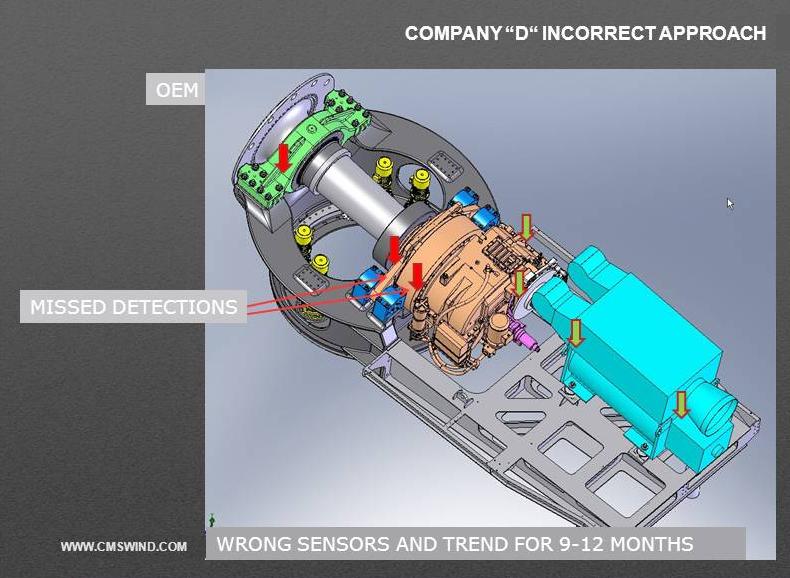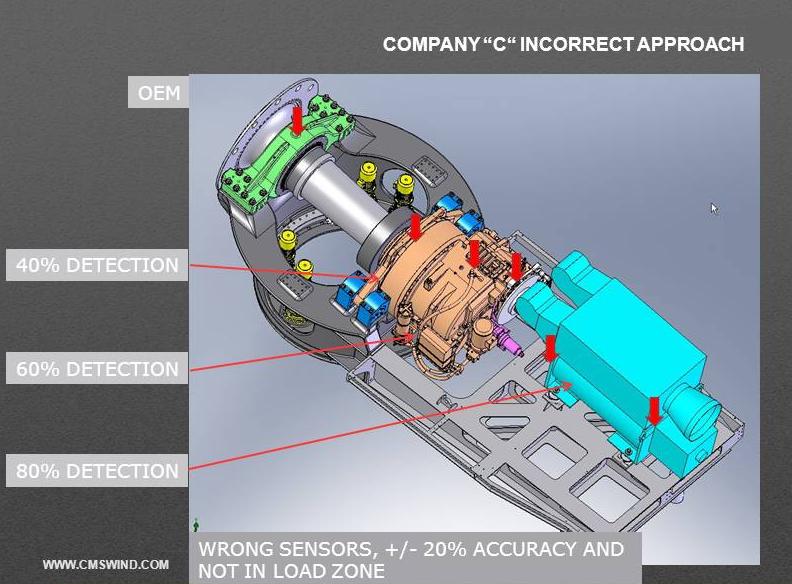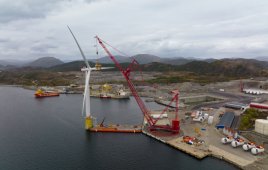David Clark / President / CMS Wind
Condition monitoring gets accolades outside the wind industry because of the value it brings to lowering O&M costs. Here’s why many in the wind industry come up short.

The green shaded arrows indicate the correct location for sensors. On the main bearing, the sensor would be mounted on the lower half of the unit.
Suppose you have recently realized the cost justification for condition monitoring. Influencing the decision is that other vertical markets already recognize the value of condition monitoring systems. But before you can pursue installation, you are halted by the question: How do you select a good system? Buying an ineffective condition-monitoring system (CMS) has contributed to the failure of wider acceptance of CMS in the wind industry and you certainly don’t want to make their mistakes.
To complicate the selection, its seems vendors play a game of “specmanship” in which each CMS manufacturer compares the features of their systems to others, looking for a competitive edge. The core functions of portable CMS devices however, are made to fit into a wide variety of vertical markets. Unfortunately, the same parity does not exist in wind CMS offerings.
 Why is it that one can pick up a portable CMS device (which for safety reasons, cannot be used in wind turbines) and software from any of six different vendors, walk into six different plants, and have all of them work well? The converse cannot be said for the wind industry. This is an important observation and it is hurting CMS, O&M costs, and the wind industry. Shame on us as consumers, vendors, and service companies for letting it perpetuate. The shortcomings affect us all.
Why is it that one can pick up a portable CMS device (which for safety reasons, cannot be used in wind turbines) and software from any of six different vendors, walk into six different plants, and have all of them work well? The converse cannot be said for the wind industry. This is an important observation and it is hurting CMS, O&M costs, and the wind industry. Shame on us as consumers, vendors, and service companies for letting it perpetuate. The shortcomings affect us all.
Part of the problem is the erroneous assumption that all condition monitoring systems for wind turbines are the same. That is like saying all cars are the same. The variances in the CM systems aimed at the wind industry creates problems and the slow acceptance of this useful technology. This is definitely not the case in the other vertical markets. Reasons for the problems in the wind industry include:
- CMS is not the developer’s core competency
- The company selling the CMS has been working with it for a short time
- The particular CMS only works for the company selling it. There are accepted standards for conducting vibration monitoring. Only about threecompanies certify in vibration to the ISO vibration standards. But most companies that market wind-specific CMS do not follow the standards and instead take their own approach to condition monitoring. So when someone says “this is our approach,” it is not the way other industries or certifying bodies approach CMS. What’s more, it is usually wrong which is why it’s an issue.
- The company selling the CMS has experience only in wind. Company experience is limited in other markets. CMS companies that provide to other vertical markets have to make products that work in all markets and applications. Therefore, the specification and adherence to standards are better because the equipment must work in a paper millas well as for Boeing.
If you buy a particular CMS system, you will have to deal with it for the life of the project. That experience will be either good or bad, so it is important to understand what you are buying. There seems to be two fundamental truths or indicators of the legitimacy of the CMS provider: Did the installer put the right sensor in the right location?

Why is it so difficult to install a system correctly? Such widespread
problems point to other systemic issues. Inevitably, the end results were
missed detections and false alarms.
Here is a comparison between a few OEM installed, condition-monitoring systems. The table is based on proper sensors in the proper location for fundamental and adequate measurement and detection.
Information in the table begs the question: Why are there seven different approaches on basic sensor placement and sensors selection? Out of seven CMS systems available through OEMs and aftermarket sources, it is easy to see that odds are high that you will purchase a system that does not have the proper sensors, or that they will be mounted in the wrong places. Sadly, this is the tip of the iceberg. The wrong sensor in the wrong location points to many other upstream issues from the installed CMS hardware.
Is it possible to correct the faulty installs so the system yields consistent and improved monitoring? That is possible, but why not do it right the first time? The problems described point to other systemic issues that will result in a period of missed detections and false alarms.
Secondly, sensor placement is critical for problem detection and indications of time to failure. The CMS vendors in the table were selected because the sensors were placed in the wrong locations. A few of which are:
- On top of the gearbox – no bearings are there.
- Incorrect axis, such as in an axial position that requires a radial position
- Missing at component locations, such as no sensor at all on the generator bearing.
 When you hear someone say they have had a less than satisfactory results with condition monitoring, you now know why. Odds are that they have a system with incorrect sensors at incorrect locations.
When you hear someone say they have had a less than satisfactory results with condition monitoring, you now know why. Odds are that they have a system with incorrect sensors at incorrect locations.
From the illustrations, “the right sensor at the right location” clearly has different meanings to each of the CMS vendors. There should not be this broad interpretation for correct sensor placement and use. Furthermore, operators should not need a vibrations class to grasp the idea that useful data and analysis comes from the proper sensors in the right locations.
For a digital copy of the entire August issue of Windpower Engineering & Development, pick here: http://goo.gl/9dlckH
Filed Under: Featured






